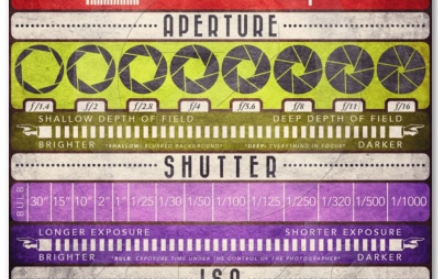aperture & shutter
Jan 2, 2013 13:31:37 #
Is there an easy way to remember the values in these. ie
small aperture is (22)?? large aperture is (1.4)?? or is it the opposite way round.
Shutter speed, it follow the same way as the aperture size.
I do understand shutter speed as 500 = 1/500 th of a second.
small aperture is (22)?? large aperture is (1.4)?? or is it the opposite way round.
Shutter speed, it follow the same way as the aperture size.
I do understand shutter speed as 500 = 1/500 th of a second.
Jan 2, 2013 13:40:44 #
Kamraman wrote:
Is there an easy way to remember the values in these. ie
small aperture is (22)?? large aperture is (1.4)?? or is it the opposite way round.
Shutter speed, it follow the same way as the aperture size.
I do understand shutter speed as 500 = 1/500 th of a second.
small aperture is (22)?? large aperture is (1.4)?? or is it the opposite way round.
Shutter speed, it follow the same way as the aperture size.
I do understand shutter speed as 500 = 1/500 th of a second.
you got the aperture concept correct. higher number is smaller opening thus less light. potential solution; you can slow down the shutter speed to allow more light to compensate for the higher aperture. play with it and have some fun you will be impressed by what your results.
Jan 2, 2013 13:56:32 #
FilmFanatic
Loc: Waikato, New Zealand
Easiest way I found is to remember that the aperture is a fraction, so f/22 is focal length divided by 22 which will be a small hole and a small number and f/1.4 is focal length divided by 1.4 which will be a large hole and a large number.
Jan 2, 2013 14:09:21 #
Kamraman wrote:
Is there an easy way to remember the values in these. ie
small aperture is (22)?? large aperture is (1.4)?? or is it the opposite way round.
Shutter speed, it follow the same way as the aperture size.
I do understand shutter speed as 500 = 1/500 th of a second.
small aperture is (22)?? large aperture is (1.4)?? or is it the opposite way round.
Shutter speed, it follow the same way as the aperture size.
I do understand shutter speed as 500 = 1/500 th of a second.
Aperture is a fraction so f/stop = 1/aperture
where f/2 = 0.5 open (more light) f/4 = 0.25 open and f/8 = 0.125 open and f/16 = 0.0625 open (less light)
Shutter speed is the amount of time the shutter mirror moves out of the way of the sensor (film)
where 1" = 1 minute and 1/100 = 1/100 of a second
Maybe the attached will help
http://livinginthestills.com/cheatsheet

Jan 2, 2013 14:36:26 #
look up ELEMENTS VILLAGE understand apeture shutters speeds and iso relationships.
click the camera demo,you can alter all your settings
and phisically see what each one does as you change it
you can also alter the light eg high medium and low
also change iso hope this helps DONNIE.
click the camera demo,you can alter all your settings
and phisically see what each one does as you change it
you can also alter the light eg high medium and low
also change iso hope this helps DONNIE.
Jan 2, 2013 16:48:25 #
FilmFanatic wrote:
This is correct. I just remember the "f" in f/stop is for fraction, so f/22 is much smaller than f/2.Easiest way I found is to remember that the aperture is a fraction, so f/22 is focal length divided by 22 which will be a small hole and a small number and f/1.4 is focal length divided by 1.4 which will be a large hole and a large number.
Jan 2, 2013 17:51:12 #
St3v3M wrote:
quote=Kamraman Is there an easy way to remember t... (show quote)
Thank you that is helpful.
For some weird reason I had it in my mind that the opposite was true. ie 22 big hole 1.4 small hole.
Know now that f is divided by 22 would be smaller.
Jan 2, 2013 17:51:38 #
Nikonian72 wrote:
FilmFanatic wrote:
This is correct. I just remember the "f" in f/stop is for fraction, so f/22 is much smaller than f/2.Easiest way I found is to remember that the aperture is a fraction, so f/22 is focal length divided by 22 which will be a small hole and a small number and f/1.4 is focal length divided by 1.4 which will be a large hole and a large number.
Thank you
Jan 2, 2013 17:54:42 #
donnie wrote:
look up ELEMENTS VILLAGE understand apeture shutters speeds and iso relationships.
click the camera demo,you can alter all your settings
and phisically see what each one does as you change it
you can also alter the light eg high medium and low
also change iso hope this helps DONNIE.
click the camera demo,you can alter all your settings
and phisically see what each one does as you change it
you can also alter the light eg high medium and low
also change iso hope this helps DONNIE.
Thank you
Jan 2, 2013 17:57:31 #
A big thank you to everyone. I am getting to use the camera settings more and more. So developing my skill and having greater satisfaction from using my Canon T3.
Jan 2, 2013 18:08:45 #
Jan 2, 2013 19:29:09 #
I always relate aperture to depth of field. The larger the aperture number, the larger the depth of field you will get. its always worked for me anyway.
Jan 3, 2013 06:23:05 #
One site I learned a lot from was camerasim.com/, neat little program that allows you to change a setting on a simulated camera and watch what other changes are made automatically by the camera, can also make changes in manual and is free.
Jan 3, 2013 06:27:36 #
Many years ago I had an instructor who gave this rule as though it were part of a song. "The bigger the number, the smaller the hole, the greater the depth of field." That simplified the whole thing in a way that even I could remember it.
Jan 3, 2013 07:04:47 #
Kamraman wrote:
Is there an easy way to remember the values in these. ie
small aperture is (22)?? large aperture is (1.4)?? or is it the opposite way round.
Shutter speed, it follow the same way as the aperture size.
I do understand shutter speed as 500 = 1/500 th of a second.
small aperture is (22)?? large aperture is (1.4)?? or is it the opposite way round.
Shutter speed, it follow the same way as the aperture size.
I do understand shutter speed as 500 = 1/500 th of a second.
Just remember that F# are actually fractions , 1/x of the focal length, even easier just put a 1 over the F# as in 1/1.8, Bob.
If you want to reply, then register here. Registration is free and your account is created instantly, so you can post right away.






